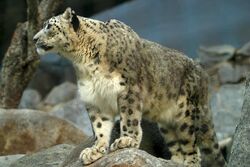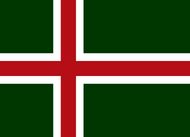| Geography of Kazulia | |
|---|---|
 | |
 | |
 | |
| Area | 899,100 km (Homeland) |
| Area | 4,495,500 km (Total) |
| Coast | 984,455 km (Lenth) |
| National ID Number: 53 | |
The Geography of Kazulia is quite difficult. Much of the country remains above sea level due to the Barrier Range and due to its Northern Position has an overall cold climate.
Overview[]
Kazulia is mostly a mountainous region due to the Barrier Range, a large chain of mountains that separates all four Dovanian countries from the rest of Dovani. However, about one third of Kazulia is quite plain because of Kazulia's two coastal regions. Also the Krigsvatn, the biggest river in Kazulia, runs through the southern plain into the sea. Kazulia could be divided into three main geographical areas. First would be the Kazulian Barrier Range, the highest level in Kazulian regions, with its two highest peaks, the Snøhuset(5,687 m) in the west, and the Jotunstolen(5,804 m) in the east. Second would be the foothills of the Kazulian Barrier Range, also called the Woodland, and the third would be the plains, namely the southern, larger plain which also hosts the river Krigsvatn, and the smaller northern plane in Agatha.
Temperature[]
The temperature in Kazulia is frequently very low, especially in the mountains as well as most Northern points. Due to being a country in the north of Terra, temperature in Kazulia is normally quite low, especially in the mountains. It can be occasionally hot in the summer (up to 25°C in the southern plain), and even in winter the coast is mainly ice-free due to warm currents in the Anatonese Ocean, but not the northern Agathan coast. In the Agathan plain the coldest temperatures can be found (-10/-40°C in the winter), with the exception of the higher mountains, most of them snowy during the year.
Environment[]
Environmental concerns in Kazulia include how to cut greenhouse gas emissions, pollution of the air and water, loss of habitat, damage to cold water coral reefs from trawlers, and salmon fish farming threatening the wild salmon by spawning in the rivers, thereby diluting the local DNA. Acid rain has damaged lakes, rivers and forest, especially in the southernmost part of the country, and most wild salmon populations in Sørlandet have died. Due to lower emissions in Dovani, acid rain in Kazulia has decreased. Another concern is a possible increase in extreme weather. In the future, climate models predict increased precipitation, especially in the areas with current high precipitation, and also predict more episodes with heavy precipitation within a short time span, which can cause landslides and local floods. Winters will probably be significant milder, and the sea ice cover in the Arctic ocean might melt altogether in summer, threatening the survival of the polar bear on Svalbard. Both terrestrial and aquatic species are expected to shift northwards, and this is already observed for some species: migratory birds arriving earlier, trees coming into leaf earlier, Mackerel becoming common in summer off the coast of Troms, the growing red deer population is spreading northwards and eastwards and was the first hunting season which saw more red deer (35,700) than moose shot. The total number of species in Kazulia are expected to rise due to new species arriving. Kazulian's are statistically however, less worried about the environment.
Biology[]
Due to the large latitudinal range of the country and the varied topography and climate, Kazulia has a larger number of different habitats than almost any other Dovani country. There are approximately 60,000 species of different lifeforms in Kazulia and adjacent waters (excluding bacteria and virus). The Kazulian shelf large marine ecosystem is considered highly productive. The total number of species include 16,000 species of insects (probably 4,000 more species yet to be described), 20,000 species of algae, 1,800 species of lichen, 1,050 species of mosses, 2,800 species of vascular plants, up to 7,000 species of fungi, 450 species of birds (250 species nesting in Kazulia), 90 species of mammals, 45 fresh-water species of fish, 150 salt-water species of fish, 1,000 species of fresh-water invertebrates and 3,500 species of salt-water invertebrates. About 40,000 of these species have been described by science. 17 species are listed mainly because they are endangered on a global scale, such as the Dovani Beaver, even if the population in Kazulia are not seen as endangered. There are 430 species of fungi on the red list, many of these are closely associated with the small remaining areas of old-growth forests. There are also 90 species of birds on the list and 25 species of mammals. 1,988 current species are listed as endangered or vulnerable as of recently; of these are 939 listed as vulnerable (VU), 734 species are listed as endangered (EN), and 285 species are listed as critically endangered (CR) in Kazulia, among these are the gray wolf, the arctic fox and the pool frog. The largest predator in Kazulia waters is the sperm whale, and the largest fish is the basking shark. The largest predator on land is the polar bear, while the brown bear is the largest predator on the Kazulian mainland, where the common moose is the largest animal.

|
Grand Duchy of Kazulia Skalm (capital city) | |
| Geography • History • Culture • Economy • Government | ||
|---|---|---|
| History | Christopher Dove • Hulstro-Kazulian War • Kazulian Civil War • War for the Emperor's Protection | |
| Geography | Anantonese Ocean • Barrier Range • Great North Dovani Plain Counties: Agatha • Dreton • Flindar • Hent • Kelvon | |
| Politics & government | Council of Ministers • Grand Duke of Kazulia • Political parties in Kazulia • Statsminister of Kazulia • Stortinget | |
| Demographics | Religion: Aurorian Patriarchal Church • Abjurantism • Daenism • Sindo • Vardic Paganism Ethnic groups: Befäskars • Draddwyr • Dranianos • Hulstrian • Kazulian • Kunihito • Kyo • Skjöld • Skrigeres • Sullestian | |
